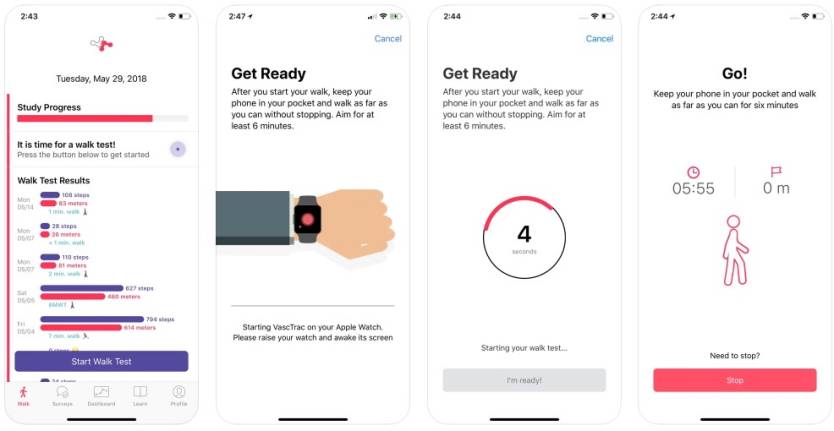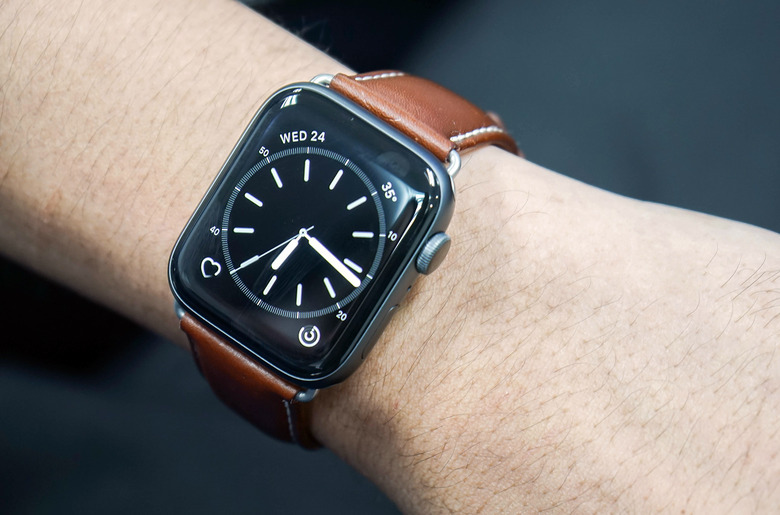Researchers Found A New Way iPhones And Apple Watches Can Save Lives
The Apple Watch is often credited with saving lives. It's usually the heart sensors which passively monitor heart activity that trigger warnings, leading to life-saving discoveries. The wearable can also detect falls, and some models feature the capability to take ECG readings. Even basic Apple Watch functionality can save lives — most recently, a person who fell into a frozen lake used Siri on the Watch to call 911.
Separately, the Watch is part of various health research programs that rely on its multiple sensors to track medical conditions in a way that wasn't possible before. And now, a team of researchers from Stanford University devised a new use for the Apple Watch and iPhone that could save more people's lives. The devices were used to passively measure frailty in patients suffering from various forms of cardiovascular disease. The resulting information could help determine the best course of action in people who need cardiovascular surgeries in order to help ensure the best possible outcome. The same health data could also be used to follow-up with patients remotely after the procedures.
Functional capacity in patients and frailty are routinely measured in clinical settings with the help of a test called the 6-minute walk test (6MWT). The researchers gave 110 participants an iPhone 7 and an Apple Watch 3 to perform the same 6MWT test at home and in a clinic. The users did not have to do anything special, as the devices were able to count distances and the number of steps taken via the VascTrac app.
The app collected the total steps taken each day, the number of steps walked without stopping for more than a minute, and the total distance walked per day. The data was collected continuously as long as the patient had either the iPhone or Watch on them. The doctors performed 6MWT tests in clinics during post-procedure follow-up visits set at regular intervals, and patients completed the 6MWT at home as well. The volunteers were observed for 6 months.

Screenshots from the VascTrac app.
The researchers compared in-clinic results to those captured at home. The Apple devices accurately assessed frailty with 90% sensitivity and 85% specificity for in-clinic 6MWT tests. The figures were slightly lower at home, at 83% and 60%, respectively. This was believed to be due to different lifestyles at home, which presents changes from day to day — and because patients might be less likely to stick to a rigorous routine. Still, both figures indicated that the iPhone and Apple Watch could be used with patients suffering from various cardiovascular diseases to remotely measure their functional capacity, especially before and after heart procedures.
"In this longitudinal observational study, passive activity data acquired by an iPhone and Apple Watch were an accurate predictor of in-clinic 6MWT performance," the researchers concluded. "This finding suggests that frailty and functional capacity could be monitored and evaluated remotely in patients with cardiovascular disease, enabling safer and higher resolution monitoring of patients."
The authors explained that a person is defined as frail if they travel less than 300 meters (900 feet) during a 6MWT test. Frailty is a known risk factor for adverse outcomes across surgical specialties, they said. "When considering an elective procedure, patients that are deemed 'frail' would ideally be enrolled in a 'prehabilitation' program to optimize their nutrition and functional status. In urgent cases, patients deemed 'frail' would be advised to have lower risk, less invasive procedures," they wrote. "A better understanding of surgical risk enhances the shared decision-making required to respect patient preferences and quality-of-life considerations. Passive activity data collection on a smartphone could be viewed as 'activity as a vital sign' and an excellent proxy for frailty with excellent negative predictive values."
The iPhone and Apple Watch can also be used to gauge the functional capacity of patients after surgery.
Of the 110 patients enrolled in the study, 85% had hypertension, 39% had diabetes, 23% had aortic stenosis, 15% had atrial fibrillation, and 4% had heart failures. Also, 109 patients were male, as the study was conducted at a VA hospital and the mean average was 68.9 years. The average BMI was 28.8, 56 patients were former smokers, and 33% were current smokers.
The patients underwent 101 procedures, including 59 peripheral arterial procedures (open bypass, endarterectomies, and endovascular procedures) and 42 cardiac procedures (coronary artery bypass graft, transaortic valve replacement, percutaneous coronary intervention, mitral valve replacement).
While the conclusions indicate that the iPhone and Apple Watch can be used for remote, passive monitoring of the functional capacity of patients suffering from various heart problems, the authors indicate that more research is required to refine the conclusions. More patients should be enrolled in similar studies, and more diverse cohorts are needed in order to draw better conclusions. Patients should also be followed for a longer period of time.
A larger sample size could also let researchers determine whether surgical procedures can lead to a significant change in daily physical activity and quality of life. The full study is available in PLOS One.
